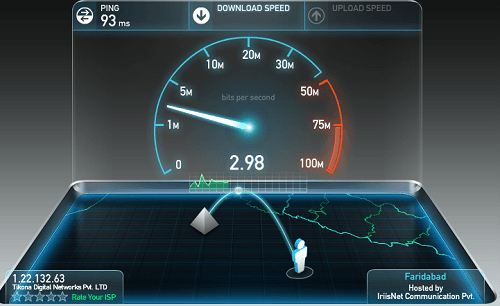

The client calculates the real-time speed of the transfers and adjusts the chunk size and buffer size based on it to maximize usage of the network connection, and requests more data.
 The client establishes multiple connections with the server over the defined port and sends an initial chunk of data. The test ends once the configured amount of time has been reached. During the first half of the test, the client will establish extra connections to the server if it determines additional threads are required to more accurately measure the download speed. As the chunks are received by the client, the client will request more chunks throughout the duration of the test. The client calculates the real-time speed of the transfers, then adjusts the chunk size and buffer size based on this calculation to maximize usage of the network connection. The client requests the server to send an initial chunk of data. The client establishes multiple connections with the server over port: 8080. This test is repeated multiple times with the lowest value determining the final result. The round-trip time is measured is measured in ms (milliseconds).
The client establishes multiple connections with the server over the defined port and sends an initial chunk of data. The test ends once the configured amount of time has been reached. During the first half of the test, the client will establish extra connections to the server if it determines additional threads are required to more accurately measure the download speed. As the chunks are received by the client, the client will request more chunks throughout the duration of the test. The client calculates the real-time speed of the transfers, then adjusts the chunk size and buffer size based on this calculation to maximize usage of the network connection. The client requests the server to send an initial chunk of data. The client establishes multiple connections with the server over port: 8080. This test is repeated multiple times with the lowest value determining the final result. The round-trip time is measured is measured in ms (milliseconds). 
The client sends a message to the server, upon receiving that message, the server sends a reply back.
This test is performed by measuring the time it takes for the server to reply to a request from the user's client. measures ping (latency), download speed and upload speed. In addition you could check internet speed with a network speed test as well to compare wireless and wired operates mainly over TCP testing with a HTTP fallback for maximum compatibility. You can run a WiFi speed test on all your devices to idenitify the ones that have a strong WiFi signal and the ones that don't. Selectively enabling and disabling your WiFi hotspots can quickly help identify the problematic device. Maybe your device is not connecting to the correct WiFi hotspot, so it must go through a thick wall. If the interet speeds differ on your connected devices, however, the poor connectivity is likely either due to a local misconfiguration or device capabilities. If the internet speeds are the same for the weak and strong signal, it's likely an ISP issue. Just run multiple tests, one close to your WiFi Hotspot and one in the place where you're having issues because the signal strength diminishes. So to figure out if your connectivity issues are due to your ISP, your wireless connection or a local router issue running a WiFi Speed Test will give you the insights you're looking for. Most of the devices on your home network today are not connected with a wired connection anymore. Running a WiFi Speed Test is the right solution for most people if they encounter connectivity issues as they are usually internet speed related.







 0 kommentar(er)
0 kommentar(er)
